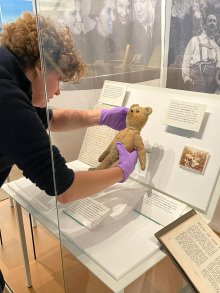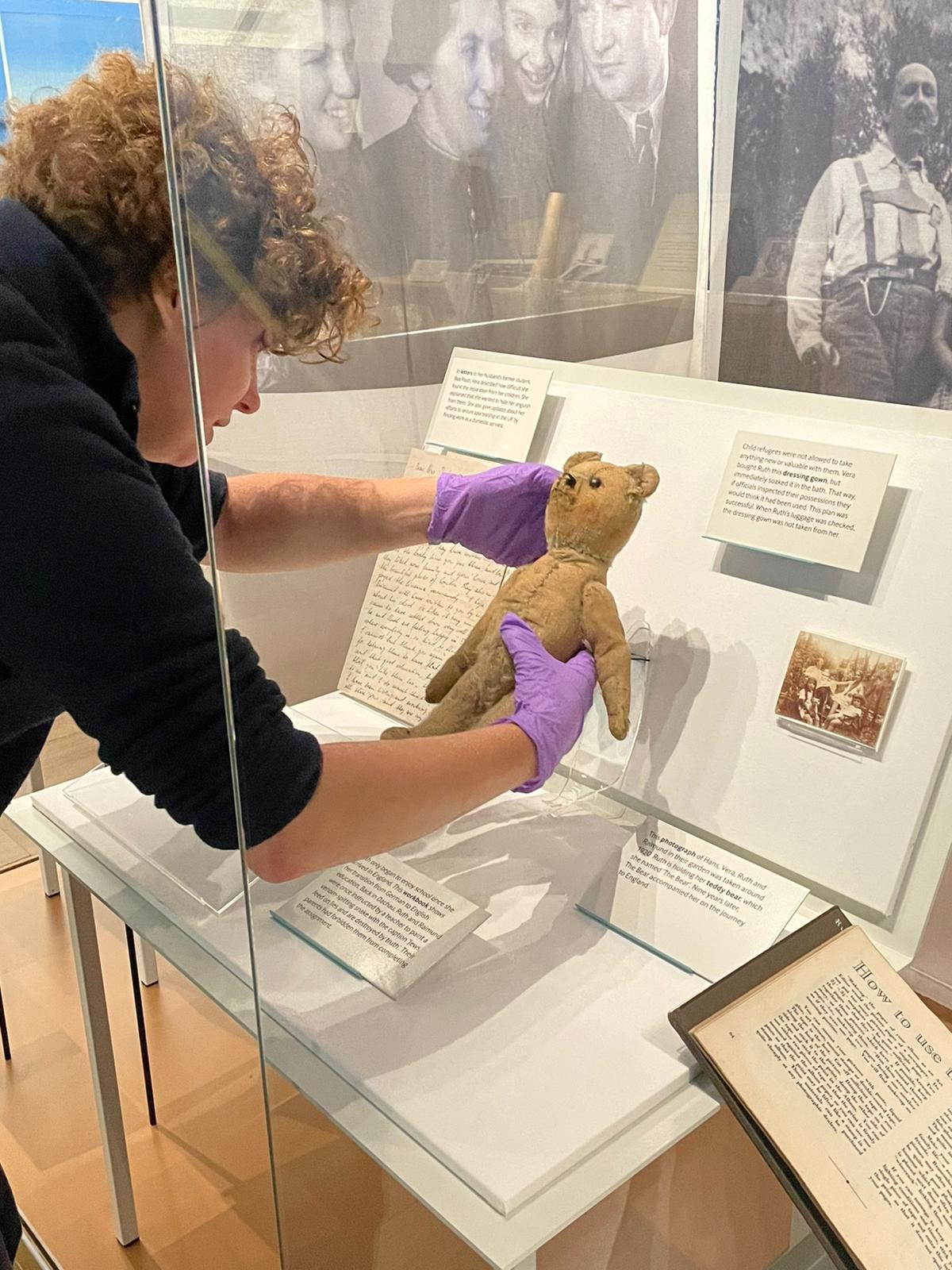







In October, the Imperial War Museum became the first in the world to house dedicated Second World War and Holocaust galleries under the same roof, changing the way young people understand the past for generations to come. It has also brought together two Alleyn’s alumni, Tim Locke (Dutton’s 1976) and Lucy May Maxwell (Roper’s 2007) who worked closely together on a special contribution to the galleries:
Tim takes up the story:
While at Alleyn’s I never discussed my mother Ruth’s narrow escape from the Holocaust with anyone. In the 1970s that wasn’t the sort of thing people talked about, and I didn’t know a lot about it anyway. But in the past seven years I’ve been piecing the story together, and the fate of her family – the Neumeyers – is now featured in the new Holocaust Galleries opened at the Imperial War Museum (IWM) in London this October.
By total coincidence, one of the curators I’ve been in close contact with over recent years in connection with setting up these galleries was Lucy: the first time she and a colleague came to visit me in Lewes we found out we had both attended Alleyn’s at different times.
Ruth and her brother Raymond departed Munich on a Kindertransport to England in May 1939, leaving their parents Hans and Vera behind on the platform: the family never met up again. Three years later both parents were deported: Hans to the Theresienstadt ghetto near Prague, and Vera to an unknown destination – either the Warsaw ghetto or Auschwitz. Neither survived.
Ruth and Raymond had been brought up as Lutherans by their mother. It was quite a bohemian, arty family: both parents were very musical – Hans was a blind pianist, composer and music teacher, and Vera taught eurythmics and English. They lived in a beautiful house in the artists’ quarter in, of all places, Dachau – and all was well until the Nazis came to power. In 1935 it transpired that because of the Nuremberg Laws the family was in great danger – Hans was Jewish, Vera was mixed race (“Mischling” in Nazi terminology) and the children were deemed Jewish because they had three Jewish grandparents. On Kristallnacht in November 1938 the family was ordered by Nazis to ‘leave by dawn or else go to prison’: thus homeless, they decamped with a few suitcases and moved to an attic in Munich.
When Ruth died in 2012 I emptied the rambling old house in Sydenham where I had been born in 1958. Astonishingly she had kept virtually everything from her past life – all the letters her parents had sent from Germany to England, her school note books, over a thousand photographs of prewar Germany, diaries dating back to 1937, sheet music, the ferry ticket for the Kindertransport and the suitcases they brought with them from Germany… the list goes on and on.
Some objects that I’d grown up with without giving much thought to them were brought over by Ruth on that Kindertransport. Her teddy bear had languished upside-down in a toy basket throughout my childhood, then spent retirement on a chair in Ruth’s bedroom, and on a hook on her bedroom door for as long as I could remember was a red and white spotted dressing gown. And there was a whole lot of silver ancestral cutlery and napkin rings that looked too special to have escaped the Nazis’ eyes – how did that lot get smuggled out?
Ruth stashed away a lot of prewar correspondence in a trunk on the upstairs landing of our Sydenham house. While she was alive I never had the nerve to pry into it – there were hundreds of letters, tightly bound up with string and in polythene bags. After she died I finally opened it up, and the story opened up with it. I started writing a blog based on the artefacts I found – and that has helped me unravel this unspoken corner of my family’s past, answering so many questions but asking so many more.
The new Holocaust Galleries simply blew me away on my first visit. It’s a very strange but wonderful feeling to see the bear, dressing gown, family letters and photographs on display to remind the world what happened, and that it should never happen again. The IWM has to my delight offered to take the entire family archive as they felt it is so substantial that it needs to be preserved in its entirety. The fate of my mother’s family has inspired me to give public talks to schools and adult groups about their story through the Holocaust education charity Generation2Generation

Lucy:
I have worked at the IWM for about a decade, starting out cataloguing film and photographs before moving into exhibition development.
I first met Tim in December 2017 when I visited him in Lewes. When he mentioned ‘growing up in South London’ within seconds of meeting, we realised that we had both gone to Alleyn’s!
It was great to have established a personal connection so easily. It would take nearly four years from that point in time for the new Holocaust Galleries to be ready to open to the public. Across those years I met with Tim several times and corresponded regularly to make sure that the display of his family’s objects in the galleries was appropriate to the people’s lives they represented.
The Neumeyer family story is told at several different points in the galleries, which are both chronological and contemporaneous. This means that we drop the visitor into the situations people faced at particular points in time without the knowledge of what was to come. Visitors first meet the Neumeyers as Ruth and Raymond part from their parents on the Kindertransport in 1939.
As well as displaying objects that the children took with them – like Ruth’s teddy bear – as a team it was also important to us to represent the anguish of the parents who were left behind. A quote from a letter written by their mother Vera is printed on fabric behind the display: ‘I miss them greatly, but please do not tell them that, as I do not want to afflict them with matters that cannot be altered for the moment.’
The next time visitors meet Vera and Hans it becomes clear that they have been unable to secure passage out of Germany in time. Vera writes: ‘Going on journey, but cheerful and happy, healthy. Father same. Keep in touch with aunt Dora Böse, Dresden, Leipzigerstrasse 147. Keep happy!’
This message is dated 9 July 1942. It was the last message Vera was able to send to her children.
There is a third space where visitors pick up the Neumeyer family story. It is in the Justice space. Raymond, the boy on the Kindertransport has grown up. He is now a soldier in the British Army. He is back in Germany in 1946 and demanding that the former mayor of Dachau, who threw his family out of their house before the war, is no longer allowed to hold public office.
It was important to the team that we could include this as we wanted to show that the children of the Kindertransport grew up and some, like Raymond, sought out those that had persecuted their families to demand justice.
It is also interesting to consider that while Ruth, Tim’s mum, did not actively seek this kind of justice for her parents, she kept every object associated with them with her for the whole of her life. It is an honour indeed for the museum to now have some of these objects in its collections and on display in the new Holocaust Galleries.
It is thanks to Tim’s generosity with his family’s story, and the generosity of many other families, that the IWM are able to tell the stories of people whose lives were ended or altered irrevocably by the events of the Holocaust. I very grateful to him for his faith in us.
Tim Locke’s blog about his mother’s family before, during and after the Holocaust is here: https://ephraimneumeyer.wordpress.com
The Holocaust Galleries https://www.iwm.org.uk/events/the-holocaust-galleries

